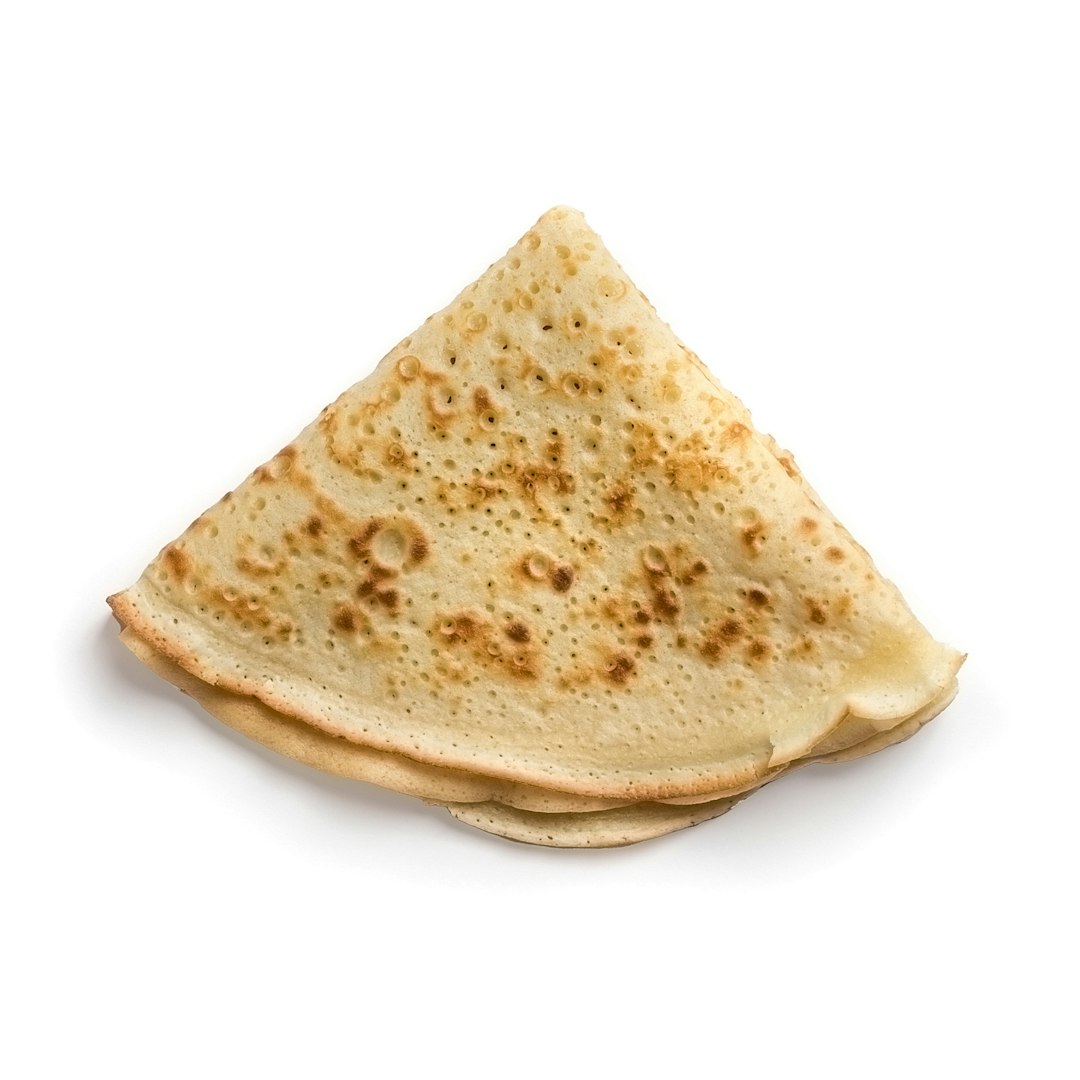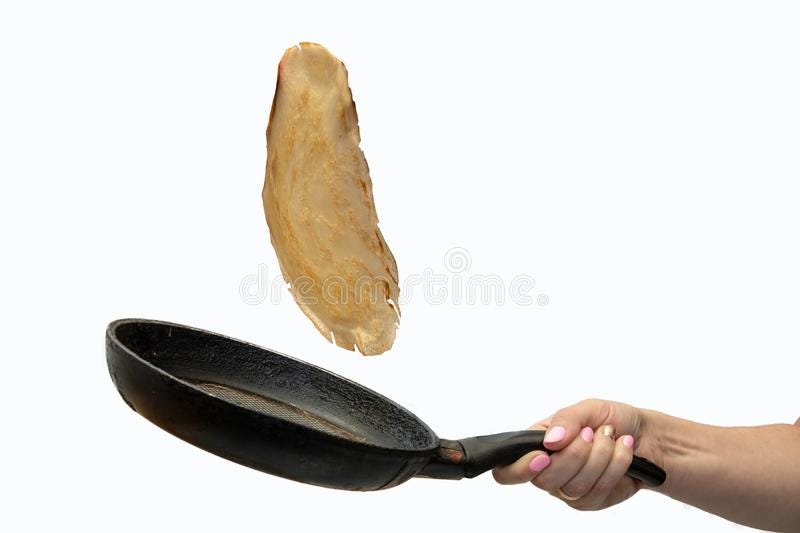Next Tuesday is carnival day - if you live in the right place. Otherwise, it’s Shrove Tuesday, more commonly known as Pancake Day or Mardi Gras (Fat Tuesday). For Christians, it’s the day before Ash Wednesday, the first day of Lent, a day of self-examination and the consideration of personal wrongs that need to be repented, requiring God to absolve or ‘shrive’ the sinner.
Pancakes are traditionally the food of the day since they use up those ingredients that can’t be eaten during the 40 days of strict Lent fasting that follow - eggs, fat and milk.
The French don’t wait for Pancake Day to make them. Actually, they don't make them at all. What they make are crêpes, a far preferable version, in my view, being thin as tissue as a consequence of not including baking powder, and a far cry from the wodge of pancakes. They make theirs to celebrate ‘La Chandeleur’ on 2nd February, Groundhog Day in the US.
‘La Chandeleur’ comes from chandelle, the French for candle. Participants would place their candles in the churches they passed. Galettes, the salty buckwheat version of the sweet crêpes, were handed out to pilgrims who had trekked to Rome for the festival.
Since the candlelit procession took place in the evening, that was the time established, to this day, for the eating of crêpes, a simple and satisfying means of using up whatever was left of stocks of flour before the new wheat harvest appeared.
The Christian origin of Shrove Tuesday is thought to go back to Pope Gelasius I.
Sometime in the 5th century, he inaugurated a candlelit procession through the streets of Rome. While February 2nd was probably settled on because it was already established as a pagan celebration of the beginning of the end of winter and the forthcoming fertility of the earth, it’s supposed to be the day that Jesus was presented at the temple in Jerusalem. It’s also associated with the day the Virgin Mary was allowed back into the church after giving birth to Jesus, linking it with purification and fecundity.
Known as well as La Fête des Crêpes and La Fête de la Lumière, La Chandeleur has as many origins and superstitions as the number of crêpes you could eat at one sitting. Some of them it shares Groundhog Day: weather superstitions predicting the end of winter.
In a manner that seems a little perverse, in France if the day is sunny, it’s said that winter and the possibility of misfortune will continue: "Soleil de la Chandeleur, annonce hiver et malheur". With the cheek-blowing, shoulder-shrugging “boff” dismissals we so love of them, for others a clear day means winter is over and done with, which makes more sense. "Quand la Chandeleur est claire, l'hiver est par derriere". If it rains on La Chandeleur, it will rain for forty days. If it’s cloudy, forty days of cloud will follow. Woe betide if it snows, there’ll be a split in the family - or even a death.
There are other rituals and superstitions surrounding the Chandeleur festival, some of them with high expectations, others extremely grim. On the eve of La Chandeleur, young women in the Vosges (a range of low mountains in eastern France near the border with Germany) so inclined fling a handful of ashes on burning embers as they recite, “Chandeleur, Chandeleur, show me while I sleep the one I will spend my life with.” People enslaved by a bad spell hoped to be cured by a soothsayer clutching a blessed candle and drawing certain symbols on the ground. Even today in some parts of France, it’s believe that to succeed in bringing the candle home still lit will guarantee the holder won’t die during the year. Another superstition predicts that if the candle’s wax only runs down one side of the candle, a loved one will not survive the year.
There are more strict beliefs which, although they apply to La Chandeleur, it wouldn’t hurt to respect when making pancakes for Shrove Tuesday - or any time of year .
Holding hold a piece of gold in your left hand (oh dear, can’t you remember where you put it?), make sure you use your right hand to grip the frying pan. This will encourage wealth and good luck throughout the coming year, an idea about as promising as a lottery ticket.
Prosperity will also come your way if instead of throwing your first crêpe away (see the pancake recipe below), you put it in a drawer or on top of a wardrobe, a piece of very good luck for mice.
Equally, take that gold coin and put it on a hot crêpe. Wrap them both in paper and slip them into a cupboard for a year’s worth of, hopefully, mouse-free prosperity if you haven’t had to dig it out to pay your fuel bills.
Crêpes and cupboards seem to go together with La Chandeleur. Anyone who successfully flips six crêpes in a row will be married in the year, but a young wife who wants to stay married must toss a crêpe on top of a wardrobe. It’s not clear whether it has to remain there. Mice will surely dispose of it if it does, so what will that do to the marriage?
A final shared link between the French and the American festitivies: Googling “Food associated with Groundhog Day”, I was hoping for hot dogs, but pancakes came up.
Shrove Tuesday comes up next week. If you want to toss any crêpes about - or even eat them, here’s a recipe that you could use by omitting the liqueur and sugar and adding salt instead to make Italian crespolini - crêpes rolled up with chopped chicken livers fried with herbs in butter and topped with a tomato sauce and baked; or with a combination of spinach, eggs, and cheese, covered in béchamel, scattered with mozzarella cheese and grated Parmigiano then baked in a hot oven until the cheese starts to melt and becomes golden brown.

250g/8oz flour
500ml/16fl oz milk
3 eggs
2 tablespoons butter, melted
½ tsp salt
3 tablespoons sugar
1 tablespoons rum or other liqueur, orange or lemon zest, or 1 teaspoon vanilla extract
cold butter for cooking (most easy if the butter is still in a wrapped block)
Pour the flour into a large measuring jug. Make a well in the middle. Pour in half the liquid and gently incorporate. Beat the eggs in a separate bowl and pour into the flour mixture. Add melted butter, sugar and salt.
Slowly mix in the remaining liquid. The batter should have the consistency of double cream. Add flavourings if using - you really shouldn’t leave the batter flavourless. Me, I most usually add 1 teaspoon vanilla extract. Although you’re supposed to cover the bowl and rest at room temperature for at least one hour, I never have. I’ve gone immediately to the cooking stage so I can’t tell you what that step contributes for the better.
Heat a medium frying pan over high heat. Peel the paper back halfway down your butter block. Gripping it by the paper, grease a frying pan with a very little butter and once very hot, pour in enough batter to just cover the bottom, turning the pan to cover evenly. As soon as the edges of the crêpe crisp up, slide a spatula underneath and flip to cook the other side. I have no idea why the first crêpe never works, but it doesn’t: you must always discard it then carry on. Cook the remainder the same way, adjusting the heat under the pan up or down depending on whether the butter is burning too fast.
Serve the crêpes at once, with a quarter of lemon, sugar, Nutella, jam, maple syrup or naked.







Clearly you have not had a lemon-ricotta pancake, or you would not so disparage the American pancake. And then there’s the Dutch Baby, corn cakes, oatmeal buttermilk pancakes. And more. (I like sour cream or yogurt on mine, but I do not so vehemently object to true maple syrup.)
Looking forward to trying these! I hate squodgy pancakes!